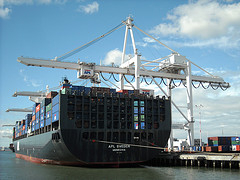For nearly four years, Cassandra Martin lived in West Oakland, a few blocks from two freeways and the city’s port. This has made her an accidental expert on air pollution.
“I used to wonder what that black stuff was on the windowsill,” said Martin, who was diagnosed with asthma in 2009. “I would constantly wipe the walls and windowsills, but it would get so caked with soot. That’s a reason I was wondering about particulate matter.”
Martin now works part time collecting air-quality data for a West Oakland environmental group.
As the hub of a busy port and freeways, much of West Oakland has been designated by the Bay Area Air Quality Management District as a Community Air Risk Evaluation site, which means residents living there face some of the greatest health risks due to toxic air.
West Oakland also has been identified as a priority development area under a 2008 state law that requires regional agencies to draft urban plans aimed at reducing greenhouse gases. Public meetings are being held in the Bay Area this year to draft its plan, which could be finalized by 2013.
But according to a recent analysis by Oakland’s Pacific Institute and a group of public health and air-quality advocates known as the Ditching Dirty Diesel Collaborative, California’s efforts to build sustainable communities as mandated by the state law could unintentionally threaten the health of Bay Area residents.
Read the complete story at California Watch. California Watch, the state’s largest investigative reporting team, is part of the independent, nonprofit Center for Investigative Reporting. For more, visit www.californiawatch.org.









